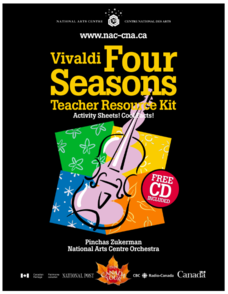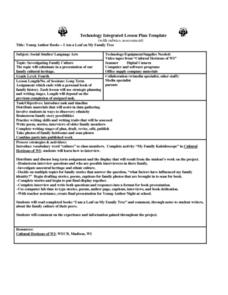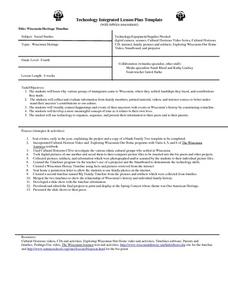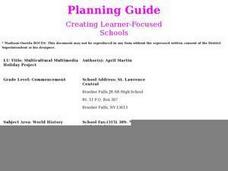Museum of Tolerance
Disenfranchised People of the New Nation
Why are some immigrant groups in the United States embraced while others become disenfranchised? To answer this question, teams investigate why groups emigrated to the US, why some of these these peoples were disenfranchised, and their...
Agriculture in the Classroom
A Rafter of Turkeys
How did that turkey get from the early Aztec culture to your table? Learn about the history of wild and domesticated turkeys in North America, as well as their inclusion in Thanksgiving traditions, with a two-part agricultural science...
Mississippi Whole School Initiative
Dream Big...With Your Eyes Wide Open
For many people, Barack Obama's presidency was the next step in Martin Luther King, Jr's dream of America's future. Explore the dreams of Americans past and present, as well as the young Americans in your class, with a set of activities...
Prestwick House
The Awakening
Kate Chopin's classic American tale, The Awakening, is the focus of a review worksheet. High school readers read the clues about the novel's characters, plot, and important quotes to fill in a crossword puzzle.
Canada's National Arts Center
Vivaldi and The Four Seasons: Teacher Resource Kit
Did you know that Vivaldi wrote "Winter," the final concerto of his The Four Seasons, in the key of F minor to echo the sleigh ride pieces popular at the time? A teacher resource kit, designed to support a study of the work, is packed...
Curated OER
Young Author Books: I Am a Leaf on My Family Tree
Fourth graders create family tree books. They discuss culture and brainstorm interview questions for family members. They write stories, poems, and captions for family photos. They interview family members and assemble the interviews...
Curated OER
Scotty T-Rex: Inspiring History All Year Round
Students study changes that occur in geological and historical time. They place themselves in relationship to the universe, the world, Canada, and Saskatchewan.
Curated OER
Japan
Seventh graders identify some key concepts, ideas, and facts about Japan. Students identify shared traits and differences of Japan as compared to other asian countries. Students identify how geography can affect the culture of a place....
Curated OER
Create Your Own Photoessay
Pupils create a photoessay that describes an aspect of the community in which they live. They participate in a photography clinic and then use digital cameras to visually document their community.They also create a narrative writing...
Curated OER
American Immigration Past and Present
Students simulate a Commission hearing in which the class attempt to arrive at an immigration policy; individual essays by each student; and, if time permits, individual or group projects based on some aspect of America's immigration...
Curated OER
Celebrating our Heritage Buildings
Ninth graders create a scavenger hunt with clues related to a building they have researched. Working in small groups, they use the internet and traditional resources to find information pertaining to a historical building. Students use...
Curated OER
The African American Heritage Trail of Martha's Vineyard
High schoolers examine sites located in Massachusetts that celebrate the history of African Americans. In groups, they read census reports and oral histories to gather more information about this group of people. They develop a...
Curated OER
Wisconsin Heritage Timeline
Fourth graders explore why groups of immigrants settled in Wisconsin. Through intervies with family members, printed materials, and internet research, 4th graders discover the contributions early residents made to the state. Students...
Curated OER
Heritage: Legends, Fairy Tales and the Native Americans
Fourth graders read a Native American legend local to the Utah region and compare it to a traditional European fairy tale. They use a Venn diagram as a graphic organizer for the comparison.
Curated OER
Weaving Heritage Through the Strands of Mountain Windsong
Tenth graders read a novel and then bring in their own artifact with a written description. They also are given a strand to read from certain historical pieces.
Curated OER
Anne Frank: Heritage
Students research questions about their ancestors and their family history. They discuss their findings and include problems of immigrants today.
Curated OER
Heritage Deer
Students trace body parts to create a deer in this excellent Kindergarten lesson that teaches basic Art skills and cultural awareness. The lesson includes a materials list, vocabulary used, a bibliography, and is best suited for use...
Curated OER
"Heritage" - "Hey, That's the Name of Our School!"
Seventh graders gain a better understanding of the canal period in U.S. History, and more specifically, discern the importance of the Illinois and Michigan Canal on the development of Illinois as a state and Chicago as a prominent city.
Curated OER
Heritage: For Some Must Push and Some Must Pull
Students discuss modes of transportation of pioneers, listen to one of the handcart stories, build model handcart out of paper, and sing 'The Handcart Song.'
Curated OER
Heritage: What Would YOU Take?
Fifth graders classify goods based on their value and decide what they would take with them if they were resettling to a new land. They write an essay defending their choices.
Curated OER
Heritage: Legends, Fairy Tales and the Native Americans
Fourth graders compare and contrast a Native American legend with a fairy tale and share their ideas by creating a venn diagram.
Curated OER
Multicultural Multimedia Holiday Project
Twelfth graders investigate a holiday of a major religion. They conduct research, develop a timeline of the origin of the holiday to the present, and create a Powerpoint presentation of their research.
Curated OER
The Lion, The Witch, and The Wardrobe: A Literature Evaluation Project
Sixth graders read and analyze The Lion, The Witch, and The Wardrobe. They study the elements of literature found in the book. Students create an elements of literature flip book that shows the various elements of literature in the novel.
Curated OER
We the People (Cultural Research)
Fourth graders conduct cultural research, collect oral histories using tape recorders and cameras, and share their ancestral heritage with classmates through family heirlooms and ethnic foods.

























